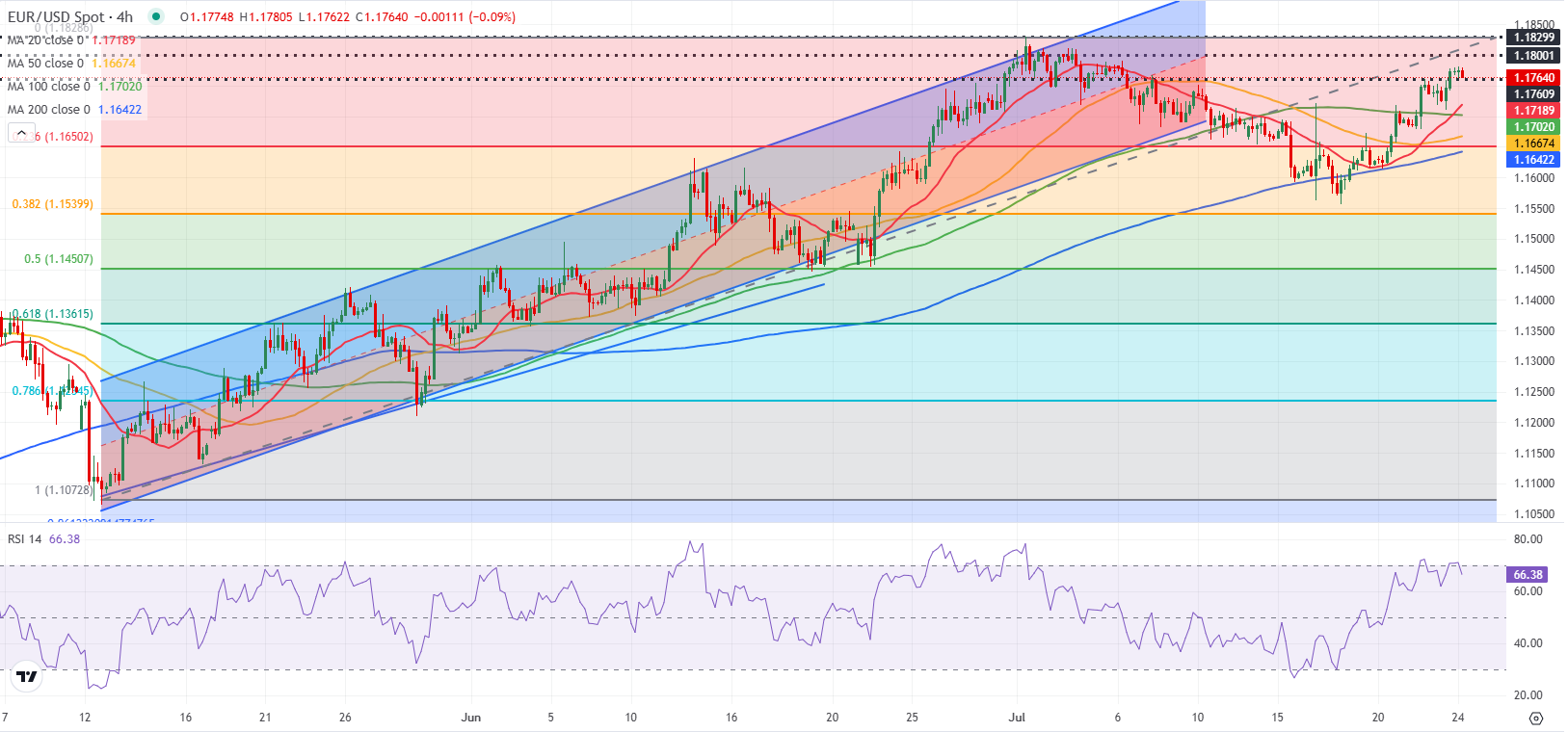
- EUR/USD holds above 1.1750 in the European session on Thursday.
- The ECB is widely anticipated to leave key rates unchanged after the July meeting.
- The pair’s bullish bias remains intact in the short-term outlook.
Following a short-lasting technical correction in the European session on Wednesday, EUR/USD regained its traction in the second half of the day to close in positive territory. The pair holds steady above 1.1750 early Thursday as investors remain on the sidelines ahead of key macroeconomic events.
Euro PRICE This week
The table below shows the percentage change of Euro (EUR) against listed major currencies this week. Euro was the strongest against the US Dollar.
| USD | EUR | GBP | JPY | CAD | AUD | NZD | CHF | |
|---|---|---|---|---|---|---|---|---|
| USD | -1.13% | -1.11% | -1.16% | -0.79% | -1.45% | -1.24% | -1.09% | |
| EUR | 1.13% | 0.10% | -0.02% | 0.32% | -0.36% | -0.29% | 0.00% | |
| GBP | 1.11% | -0.10% | -0.34% | 0.28% | -0.42% | -0.17% | 0.11% | |
| JPY | 1.16% | 0.02% | 0.34% | 0.38% | -0.24% | -0.12% | 0.25% | |
| CAD | 0.79% | -0.32% | -0.28% | -0.38% | -0.59% | -0.44% | -0.34% | |
| AUD | 1.45% | 0.36% | 0.42% | 0.24% | 0.59% | 0.15% | 0.50% | |
| NZD | 1.24% | 0.29% | 0.17% | 0.12% | 0.44% | -0.15% | 0.27% | |
| CHF | 1.09% | -0.00% | -0.11% | -0.25% | 0.34% | -0.50% | -0.27% |
The heat map shows percentage changes of major currencies against each other. The base currency is picked from the left column, while the quote currency is picked from the top row. For example, if you pick the Euro from the left column and move along the horizontal line to the US Dollar, the percentage change displayed in the box will represent EUR (base)/USD (quote).
The risk-positive market atmosphere, on news of the US and Japan reaching a trade deal, made it difficult for the US Dollar (USD) to gather strength and allowed EUR/USD to stretch higher on Wednesday.
On Thursday, preliminary July Manufacturing and Services Purchasing Managers Index (PMI) data from Germany and the Eurozone will be featured in the US economic calendar. More importantly, the European Central Bank (ECB) will announce monetary policy decisions following the July meeting.
The ECB is widely anticipated to leave its key rates unchanged. The uncertainty surrounding the impact of the EU-US trade relations on the inflation outlook is likely to cause the ECB to adopt a cautious tone regarding further policy easing in the near term. In this scenario, the Euro is likely to stay resilient against its rivals.
However, citing two European diplomats, Reuters recently reported that the EU and the US are closing in on a trade agreement that could include a 15% US baseline tariffs on European imports, alongside some exemptions. If the EU and the US reach a deal, investors could see this as a sign that could allow the ECB to ease the policy further, causing the Euro to come under pressure.
In the second half of the day, S&P Global will publish July Manufacturing and Services PMI data for the US. If either of the PMIs come in below 50 and reflect a contraction in the respective sector’s economic activity, the USD could weaken against its peers.
Finally, the White Announced late Wednesday that US President Donald Trump will visit the Federal Reserve (Fed) on Thursday. If the headlines coming out of that meeting suggest that Trump is easing on his criticism of the US central bank’s decisions, the immediate market reaction could be supportive for the USD.
EUR/USD Technical Analysis

The Relative Strength Index (RSI) indicator on the 4-hour chart stays slightly below 70, suggesting that EUR/USD has more room on the upside before turning technically overbought.
On the upside, 1.1800 (static level, round level) aligns as the immediate resistance level ahead of the multi-year-high set at 1.1830 earlier in the month and 1.1900 (static level, round level). Looking south, the first support level could be spotted at 1.1700 (100-period Simple Moving Average) before 1.1650-1.1640 (Fibonacci 23.6% retracement level of the latest uptrend, 200-period Simple Moving Average) and 1.1600 (static level, round level).
ECB FAQs
The European Central Bank (ECB) in Frankfurt, Germany, is the reserve bank for the Eurozone. The ECB sets interest rates and manages monetary policy for the region. The ECB primary mandate is to maintain price stability, which means keeping inflation at around 2%. Its primary tool for achieving this is by raising or lowering interest rates. Relatively high interest rates will usually result in a stronger Euro and vice versa. The ECB Governing Council makes monetary policy decisions at meetings held eight times a year. Decisions are made by heads of the Eurozone national banks and six permanent members, including the President of the ECB, Christine Lagarde.
In extreme situations, the European Central Bank can enact a policy tool called Quantitative Easing. QE is the process by which the ECB prints Euros and uses them to buy assets – usually government or corporate bonds – from banks and other financial institutions. QE usually results in a weaker Euro. QE is a last resort when simply lowering interest rates is unlikely to achieve the objective of price stability. The ECB used it during the Great Financial Crisis in 2009-11, in 2015 when inflation remained stubbornly low, as well as during the covid pandemic.
Quantitative tightening (QT) is the reverse of QE. It is undertaken after QE when an economic recovery is underway and inflation starts rising. Whilst in QE the European Central Bank (ECB) purchases government and corporate bonds from financial institutions to provide them with liquidity, in QT the ECB stops buying more bonds, and stops reinvesting the principal maturing on the bonds it already holds. It is usually positive (or bullish) for the Euro.
Information on these pages contains forward-looking statements that involve risks and uncertainties. Markets and instruments profiled on this page are for informational purposes only and should not in any way come across as a recommendation to buy or sell in these assets. You should do your own thorough research before making any investment decisions. FXStreet does not in any way guarantee that this information is free from mistakes, errors, or material misstatements. It also does not guarantee that this information is of a timely nature. Investing in Open Markets involves a great deal of risk, including the loss of all or a portion of your investment, as well as emotional distress. All risks, losses and costs associated with investing, including total loss of principal, are your responsibility. The views and opinions expressed in this article are those of the authors and do not necessarily reflect the official policy or position of FXStreet nor its advertisers. The author will not be held responsible for information that is found at the end of links posted on this page.
If not otherwise explicitly mentioned in the body of the article, at the time of writing, the author has no position in any stock mentioned in this article and no business relationship with any company mentioned. The author has not received compensation for writing this article, other than from FXStreet.
FXStreet and the author do not provide personalized recommendations. The author makes no representations as to the accuracy, completeness, or suitability of this information. FXStreet and the author will not be liable for any errors, omissions or any losses, injuries or damages arising from this information and its display or use. Errors and omissions excepted.
The author and FXStreet are not registered investment advisors and nothing in this article is intended to be investment advice.








